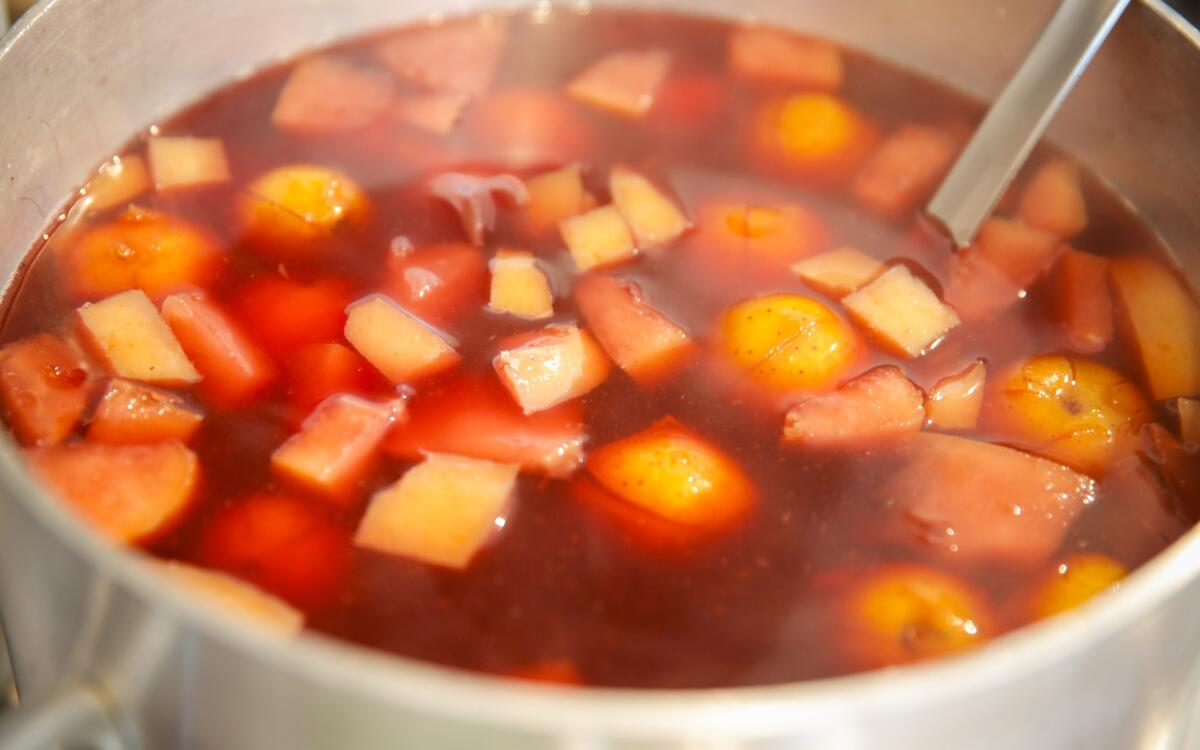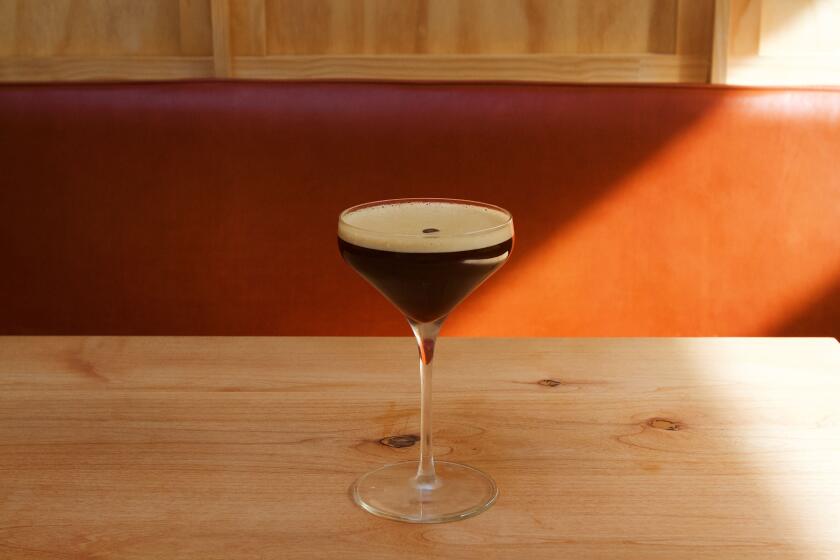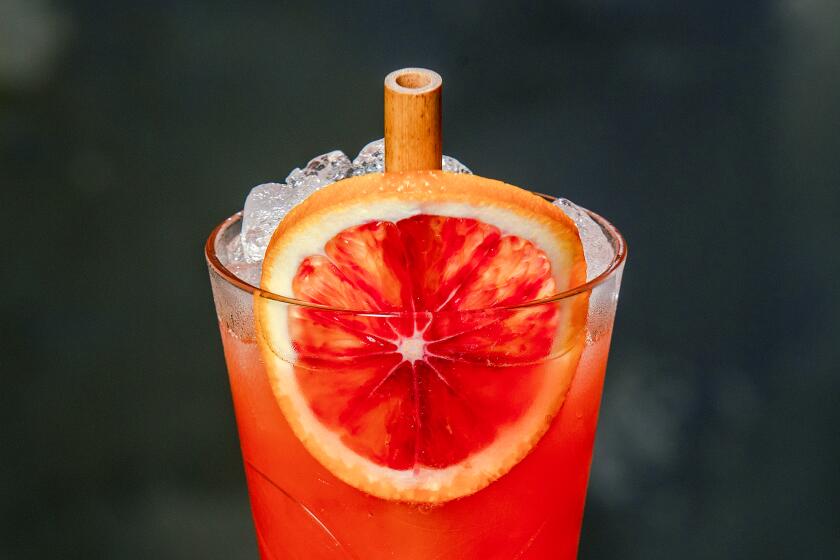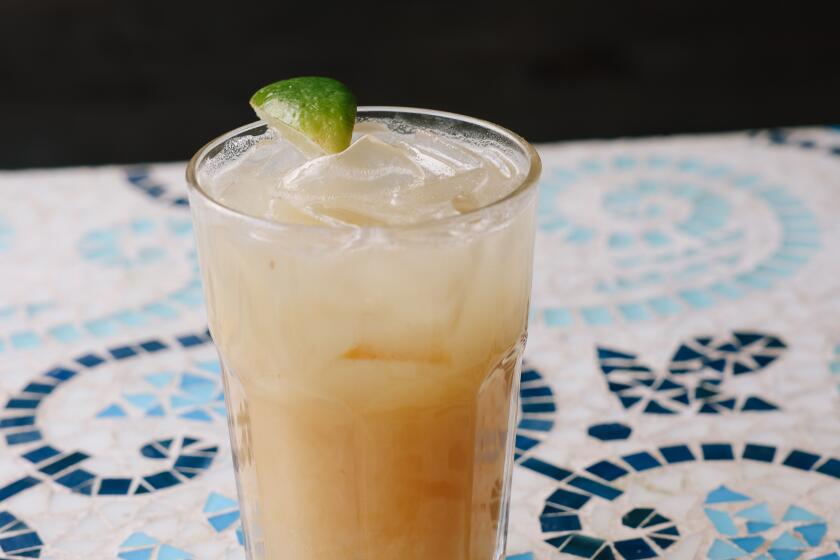Christmas ponche

How do you know it’s Christmas at Bricia Lopez’s house? There’s a big Christmas tree in one corner of the art-filled hillside bungalow; a baby bobs in his bouncy chair. Bricia, her sisters Elizabeth Lopez and Paulina Lopez Velasquez, and her mother, Maria de Jesus, wear coordinated Oaxacan aprons (her father, Fernando Lopez, naps on the porch), and old Mexican ballads pour from the stereo. Someone has already pressed a snifter of mezcal into your hand.
Or you could just inhale. The fragrance of spices, mezcal and burnt things, roasting chiles and simmering poultry is intoxicating — pure Oaxacan Christmas.
The Lopez family has run the Koreatown Oaxacan restaurant Guelaguetza since the early 1990s, a perennial on The Times’ 101 Best Restaurants list and selected by the James Beard Foundation as one of its America’s Classics earlier this year. Guelaguetza is where the governor of Oaxaca state eats when he visits Los Angeles. This isn’t just a Oaxacan kitchen — it is perhaps the most Oaxacan home kitchen in town. That smoky, pungent Oaxacan mezcal in your glass comes from a tiny 41-liter batch. You aren’t going to find it at BevMo.
In the open kitchen — the house seems all kitchen — the Lopezes steep spices and fruit for punch, whiz peeled poblanos in a blender with Mexican crema to sauce a bowl of spaghetti, and oven-braise a huge pan of chicken barbacoa. “That spaghetti, it smells just like Christmas,” Paulina says. Maria prepares intricate Oaxacan bean tamales made from masa prepared without salt or lard, pressing dried avocado leaves into the dough and folding them like thin envelopes around beans flavored with the minty Oaxacan herb poleo before she tucks them into corn husks to steam.
You have probably never seen poleo, not even in a well-stocked Mexican supermarket. You sniff an avocado leaf, anise, a faint muskiness, and a deep note not unlike what you might smell in well-aged pu-erh tea. She informs you that the avocado leaves are a special kind, also brought up from Oaxaca, and that you can’t just substitute leaves from the tree in your backyard.
That batch of tamales done, she starts on another, this one wrapped in banana leaves and stuffed with black mole and chicken. You realize that you could stand in Bricia’s kitchen watching her mother make tamales all day.
“In Mitla, my town in Oaxaca, when you go visiting during the holiday season,” says Bricia, “you bring mole as a gift, and they give you mole as a party favor.”
“When you’re the mother of the bride: mole,” Maria says. “When you’re the hostess: mole. If you are grieving: mole. When you are celebrating a grandchild: mole.”
“It’s every day from Halloween through Christmas in Oaxaca, pretty much. Mole, mole mole,” Bricia says. “So much mole. Everywhere, mole. That’s why we make all these tamales, enmoladas, chilaquiles, tlayudas with mole. We’ve got a lot of mole to get through.”
Don’t you get tired of it after a while?
“Of course not,’’ says Bricia. “It’s mole!”
Her mother picks up a sheet of plastic wrap, plops a blob of masa into the center of a trimmed banana leaf and smooths the mass under the wrap until it becomes an even, thin layer reaching all the way to the edges of the leaf. She carefully peels off the plastic and piles a small handful of shredded chicken breast in the middle of the rectangle. She sloshes a big spoonful of glossy, black mole over the chicken, almost hip-deep, and finishes with a light sprinkle of salt.
“This mole?” Bricia says. “It comes from a jar. The black mole we make at the restaurant is next-level, with probably twice as many ingredients and a lot more flavor, but the one we sell in jars is still really, really good. I use it all the time — especially for tamales.”
She sighs. Her mother smiles and hands her a steaming mug of punch.
In a large pot, combine the water, sugar, cinnamon and piloncillo over high heat until the water comes to a boil. Add the tejocotes and sugar cane. After 5 minutes, add the apples, hibiscus, prunes, raisins and tamarind. After 5 more minutes, add the guava. Reduce the heat to low. Serve hot, with rum, if desired.
Get our Cooking newsletter.
Your roundup of inspiring recipes and kitchen tricks.
You may occasionally receive promotional content from the Los Angeles Times.
















